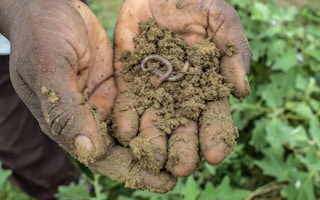Recently, agriculture has been in the news for its many negative effects on the environment; driving deforestation, biodiversity loss, water pollution and greenhouse gas emissions.
To continue reading, subscribe to Eco‑Business.
There's something for everyone. We offer a range of subscription plans.
- Access our stories and receive our Insights Weekly newsletter with the free EB Member plan.
- Unlock unlimited access to our content and archive with EB Circle.
- Publish your content with EB Premium.
We now know that in the ambition to feed the world, our drive for efficiency and increasing production of crops and livestock has jeopardised nature and agriculture’s most important asset: the soil.
Mass production through monoculture farming and the incorrect use of chemical fertilisers and pesticides have damaged the valuable soil life and delicate ecosystem that provides the nutrients and water supply to crops grown to feed animals and humans. This, in turn, threatens the long-term productivity of the land and makes the livelihoods of people who depend on it, like farmers, vulnerable.
But it does not have to be this way. We can change the way we practice agriculture to work with nature and restore and regenerate healthy soils. The solution to many of these problems lies in ‘staying down-to-earth’ and changing our relationship with the natural resource right beneath our feet.
“
The world cannot be fed unless the soil is fed.
Project Drawdown
Soil is the basis of life on Earth
Healthy soils are the living, breathing ecosystems that produce food and fuel, regulate our water cycle, store carbon, recycle waste and reduce the risk of droughts and floods. If we want productive farms, nutritious food, and healthy communities and economies, we must have healthy soils. Quoting Project Drawdown, “The world cannot be fed unless the soil is fed.” If we don’t change the way we use natural resources to produce our food, we will not be able to feed our growing population.
We need to innovate and transform our systems. Our soils are degrading at an alarming rate. One quarter of our global land area and 52 per cent of agricultural land area is degraded. This means the land is at grave risk of no longer being capable of delivering food, water and liveable conditions for humans.
Regenerative agriculture is key to healthy soils
Maintaining healthy soils is the key. That means that we must restore what is already degraded and start applying approaches that keep our soils healthy and productive.
Regenerative agriculture aims to sustain healthy soil by restoring its carbon content, which improves productivity. It uses farming practices like conservation tillage, cover crops, crop rotation, composting, mobile animal shelters and pasture cropping to increase carbon-rich organic matter.
The result is that vital microbes proliferate, roots go deeper, nutrient uptake improves, water retention increases, plants are more pest-resistant, and soil fertility compounds.
Restoring and regenerating soil fertility helps safeguard farmers’ livelihoods so they can grow the food we need now and in the future.
Building a movement
We recognise that adopting regenerative agricultural practices requires a fundamental shift to our ways of working. Funders, governments, investors and practitioners need evidence that it can restore degraded land while feeding the world and ensuring a fair livelihood for farmers.
That is why, at the IKEA Foundation, we support organisations that understand the importance and potentials of working on regenerative agriculture and develop models that benefit both people and planet.
But our future depends on a collective effort to change the way we produce food and use our valuable land.
As more people realise the importance of healthy food from healthy soils, we need more funders to join us in supporting programmes that regenerate our soil. More businesses must commit to regenerating the natural resources they depend on. More governments must put policies in place that prioritise the connected wellbeing of our planet, our societies, our economies and our families.
It has never been clearer that our future and the future of the planet are intrinsically linked.
We all want our families to have a decent living, nutritious food and a plentiful income. We cannot secure that future unless we invest in the health of our soil. We know what needs to be done. It’s up to us to accelerate this transformation.
Together, we can generate the energy and creativity to regenerate the soil and, in turn, our planet.
Petra Hans is head of portfolio, agricultural livelihoods at IKEA Foundation











